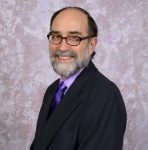Rabbinic Pastor Simcha Raphael will be a scholar-in-residence at Congregation Or Shalom for a Shabbaton Nov. 25-26. (photo from Simcha Raphael)
Later this month, Congregation Or Shalom is hosting a Shabbaton featuring Rabbinic Pastor Simcha Raphael, a bereavement counselor and expert in Jewish beliefs and sacred practices around death and the afterlife.
Founding director of Da’at Institute for Death Awareness, Advocacy and Training, Raphael also has a psychology practice specializing in grief counseling and bereavement support, and is an adjunct assistant professor in the Jewish studies department of Temple University in Philadelphia. While in Vancouver, he will participate in various educational activities at Or Shalom, sharing observations from his decades-long study of related Jewish wisdom and customs.
Raphael’s interest in the afterlife began in personal experience. When he was 4 years old, his Bubby Mina died. As was common for children at the time, he did not attend the funeral or shivah, but he was told that she had “gone to heaven.” In his young mind, this meant she was still alive and accessible and, for years afterward, he found comfort in talking to her.
Years later, when the rabbi was 22, a good friend died in a car accident. Heartbroken, Raphael found that he had a continued sense of his friend’s presence. This experience, together with his childhood memories of talking to his grandmother, came together as both a question and an inspiration. Raphael was already studying psychology and world religions – he turned his focus on what Judaism says about the afterlife.
Then, as now, many Jews and non-Jews wrongly believed that Judaism does not have anything to say about the afterlife. But, as Raphael investigated the textual tradition, he found that the Torah, Talmud, kabbalistic writings and Jewish folklore all painted a very different picture.
“In the world of the Chassidim, the world of the Ashkenazi shtetl, there was no question about the reality of the spiritual realms and their interaction with this world,” Raphael told the Independent.
As many Jews eagerly embraced modernity, these traditions were suppressed or forgotten. With the encouragement of his mentor, Reb Zalman Shachter-Shalomi, Raphael undertook to unveil these traditions for modern Jewry. In his now-classic Jewish Views of the Afterlife, published in 1994, Raphael provided a comprehensive discussion on these issues for a popular audience. A 25th anniversary edition of the work with a foreword by Arthur Green is expected in 2019.
Raphael has found that traditional rituals and beliefs around death can have therapeutic value, whether those dealing with these transitions believe in a tangible afterlife or not. “For example,” he said, “traditionally it is believed that the soul stays behind for seven days after death, preparing to leave. Mourners can be encouraged to take this time to say things they wished to say to their loved one, whether they literally believe their words are heard or not. I have found that this practice has great value for people.”
At the upcoming Shabbaton, Raphael will share rituals like this one, as well as explore the rich traditional lore Judaism possesses around death and the afterlife.
Raphael’s teaching program at Or Shalom runs Nov. 25-26 and is called Judaism and the Mysteries of Life, Death and the World Beyond. He will address what the Hebrew Bible, Jewish custom and the kabbalah can tell us about death and dying. On the Saturday, at 7 p.m., he will offer a community talk called Twilight Between the Worlds: Jewish Ghost Stories, which will take place at Celebration Hall at Mountain View Cemetery.
For more information about and registration for the Shabbaton weekend, visit orshalom.ca/shabbaton2016. Admission to the Saturday night cemetery event is free but seating is limited, so an RSVP is requested to orshalom.ca/jewishghoststories.
Matthew Gindin is a freelance journalist, writer and lecturer. He writes regularly for the Forward and All That Is Interesting, and has been published in Religion Dispatches, Situate Magazine, Tikkun and elsewhere. He can be found on Medium and Twitter.

